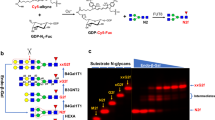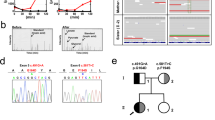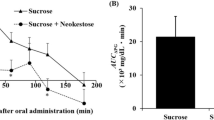Abstract
Isoelectrofocusing of serum sialotransferrins from patients with untreated hereditary fructose intolerance (HFI) shows a cathodal shift similar to that in carbohydrate-deficient glycoprotein (CDG) syndrome type I and in untreated galactosemia. This report is on serum lysosomal enzyme abnormalities in untreated HFI that are identical to those found in CDG syndrome type I but different from those in untreated galactosemia. CDG syndrome type I is due to phosphomannomutase deficiency, a defect in the early glycosylation pathway. It was found that fructose 1-phosphate is a potent competitive inhibitor(Ki ≃ 40 μM) of phosphomannose isomerase (EC 5.3.1.8), the first enzyme of the N-glycosylation pathway thus explaining the N-glycosylation disturbances in HFI.
Similar content being viewed by others
Main
HFI is an autosomal recessive disorder due to fructose 1-phosphate aldolase deficiency in liver, kidney cortex, and small intestine(1). Recently, it was reported that isoelectrofocusing of serum sialotransferrins from patients with HFI before treatment showed a cathodal shift (suggestive of hypoglycosylation) similar to that in CDG syndrome type I and in untreated galactosemia(2). CDG syndrome type I is an autosomal recessive, multisystem disorder characterized by hypoglycosylation of secretory glycoproteins, lysosomal enzymes, and probably also membrane glycoproteins(3–5). We investigated the serum lysosomal enzymes β-hexosaminidase andβ-glucuronidase in two patients with HFI before treatment and found abnormalities identical to those in CDG syndrome type I but different from those in untreated galactosemia. Inasmuch as CDG syndrome type I is due to a deficiency of phosphomannomutase(6)(Fig. 1), an enzyme of the earlyN- glycosylation pathway, we hypothesized that fructose 1-phosphate accumulating in HFI might inhibit the same or another enzyme of the earlyN- glycosylation pathway.
METHODS
Fructose 1-phosphate was from Sigma Chemical Co. (St. Louis, MO). The source of other products was described previously(6). Isoelectrofocusing of serum β-hexosaminidase was performed on agarose gel in a pH gradient 5.0-8.0 with a Pharmacia Biotech Inc. (Piscataway, NJ) Phast apparatus(7). Activities of β-hexosaminidase andβ-glucuronidase were measured with fluorogenic substrates following standard methods.
The purification of phosphomannose isomerase (EC 5.3.1.8) from rat livers, the preparation of the homogenate, of a 6-22% polyethyleneglycol fraction, and its fractionation on DEAE-Sepharose were as described previously(8). Phosphomannose isomerase was eluted at about 50 mM KCl, with a specific activity of 1.5 U/mg protein; fractions were pooled and stored at -80 °C until use. The preparation of recombinant human phosphomannomutase will be reported elsewhere (G. Matthijs, in preparation). For the preparation of phosphoglucose isomerase, a 6-22% polyethyleneglycol fraction was chromatographed on SP-Trisacryl, which was developed with a KCl gradient. The most active fractions (about 7 U/mg protein) were pooled and used to realize the assays.
Phosphomannose isomerase was measured by the conversion of mannose 6-phosphate to fructose 6-phosphate as described previously(6). Phosphomannomutase was assayed through the conversion of mannose 1-phosphate to mannose 6-phosphate(6) with the following modifications: the concentration of mannose 1,6-biphosphate was 5 μM and that of phosphomannose isomerase was increased about 15-fold, to cope with the inhibition of the enzyme by fructose 1-phosphate. At the most elevated concentrations of fructose 1-phosphate investigated (1 mM) a two-step assay was used: the reaction was run in the absence of auxiliary enzymes (glucose-6-phosphate dehydrogenase, phosphoglucose isomerase, and phosphomannose isomerase) for 10 min and was arrested by a 5-min incubation at 80 °C; the mannose 6-phosphate concentration was then measured by the addition of the auxiliary enzymes.
Phosphoglucose isomerase was assayed spectrophotometrically at 30 °C in the presence of 25 mM HEPES, pH 7.1, 0.25 mM NADP, 25 mM MgCl2, and 5μg/mL glucose-6-phosphate dehydrogenase. In all cases, one unit of enzyme is defined as the amount catalyzing the formation of 1 μmol of product/min under the assay conditions stated.
RESULTS
The isoelectrofocusing of serum β-hexosaminidase before dietary treatment showed in both patients a cathodal shift nearly identical to that in CDG syndrome type I. Activities of β-hexosaminidase andβ-glucuronidase were significantly increased in both patients (two to four times the upper control levels, as seen in CDG syndrome type I). A repeat analysis after 3 wk of a fructose-free diet showed a normal isoenzyme pattern and normal enzyme activities.
As shown in Fig. 2, fructose 1-phosphate is a powerful inhibitor of phosphomannose isomerase from rat liver. In the absence of inhibitor this enzyme displays a Km of 60 μM. Fructose 1-phosphate behaved as a competitive inhibitor with aKi of about 30 μM. This value is about 40-fold lower than the Ki reported for rabbit liver phosphoglucose isomerase (1.3 mM) and rat liver phosphoglucose isomerase (1.2 mM)(9). This result is not surprising, because fructose 1-phosphate is essentially present in the β-fructopyranose configuration which is a closer analog of mannose 6-phosphate than of glucose 6-phosphate(Fig. 3).
In contrast to the isomerases, human recombinant phosphomannomutase (G. Matthijs, in preparation), when tested at a substrate concentration close to its Km (6.5 μM mannose 1-phosphate) was not inhibited by 1 mM fructose 1-phosphate. Higher concentrations could not be tested due to inhibition of the yeast phosphomannose isomerase used to detect the formation of product.
DISCUSSION
Taken together with the finding of an abnormal sialotransferrin pattern(2), these results indicate that HFI is a secondary CDG syndrome. In CDG syndrome type I, as a consequence of an early glycosylation defect, there is a partial deficiency of the glycoprotein sugar moieties including the terminal sialic acid(4). Sialic acid bears a negative electric charge, and the deficiency of this carbohydrate residue explains the cathodal shift of sialotransferrins and other glycoproteins. The remarkable similarity between the β-hexosaminidase isoenzyme pattern of CDG syndrome type I and HFI suggested a common underlying cause or at least very related underlying causes for the hypoglycosylation in both disorders. CDG syndrome type I has very recently been found to be due to phosphomannomutase deficiency(6), a defect in the second step of the N-glycosylation pathway (Fig. 1). Therefore we investigated the effect in vitro of fructose 1-phosphate on the enzyme activities of the early N-glycosylation pathway and found this compound to be a powerful inhibitor of liver phosphomannose isomerase.
Because fructose 1-phosphate accumulates to concentrations of 2-5 mmol/kg in the livers of patients with HFI(10, 11), these data provide evidence that in HFI there is a fructose 1-phosphate-induced inhibition of the first step of theN- glycosylation pathway causing the same (or a very similar) hypoglycosylation syndrome as in CDG syndrome type I. A difference with CDG syndrome type I is that the hypoglycosylation in HFI is probably limited to those tissues that possess the specialized fructose pathway, namely liver, kidney cortex, and small intestinal mucosa(1). It is suggested that this hypoglycosylation, together with the known depletion of ATP and the inhibition of gluconeogenesis and glycogenolysis(1), plays a major role in the pathogenesis of HFI.
Finally, the isoelectrofocusing pattern of β-hexosaminidase in HFI is very different from that reported in galactosemia(7). This is evidence that the hypoglycosylation in galactosemia(7, 12–14) is not due to an earlyN- glycosylation defect.
Abbreviations
- CDG:
-
carbohydrate-deficient glycoprotein
- HFI:
-
hereditary fructose intolerance
References
Gitzelmann R, Steinmann B, Van den Berghe G 1995 Disorders of fructose metabolism. In: Scriver C, Baudet A, Sly W, Valle D(eds) The Metabolic and Molecular Bases of Disease. McGraw-Hill, New York, pp 905–934.
Adamowicz M, Pronicka E 1996 Carbohydrate deficient glycoprotein syndrome-like transferrin isoelectric focusing pattern in untreated fructosaemia. Eur J Pediatr 155: 347–348.
Jaeken J, Vanderschueren-Lodeweyckx M, Casaer P, Snoeck L, Corbeel L, Eggermont E, Eeckels R 1980 Familial psychomotor retardation with markedly fluctuating serum prolactin, FSH and GH levels, partial TBG deficiency, increased arylsulphatase A and increased CSF protein: a new syndrome?. Pediatr Res 14: 179
Jaeken J, Carchon H, Stibler H 1993 The carbohydrate-deficient glycoprotein syndromes: pre-Golgi and Golgi disorders?. Glycobiology 3: 423–428.
Stibler H, Blennow G, Kristiansson B, Lindehammer H, Hagberg B 1994 Carbohydrate-deficient glycoprotein syndrome: clinical expression in adults with a new metabolic disease. J Neurol Neurosurg Psychiatry 57: 552–556.
Van Schaftingen E, Jaeken J 1995 Phosphomannomutase deficiency is a cause of carbohydrate-deficient glycoprotein syndrome type I. FEBS Lett 377: 318–320.
Jaeken J, Kint J, Spaapen L 1992 Serum lysosomal enzyme abnormalities in galactosemia. Lancet 340: 1472–1473.
Vandercammen A, Van Schaftingen E 1990 The mechanism by which rat liver glucokinase is inhibited by the regulatory protein. Eur J Biochem 191: 483–489.
Zalitis J, Oliver IT 1967 Inhibition of glucose phosphate isomerase by metabolic intermediates of fructose. Biochem J 102: 753–759.
Boesiger P, Buchli R, Meier D, Steinmann B, Gitzelmann R 1994 Changes of liver metabolite concentrations in adults with disorders of fructose metabolism after intravenous fructose by 31P magnetic resonance spectroscopy. Pediatr Res 36: 436–440.
Pitkänen E, Perheentupa J 1962 Eine biochemische Untersuchung über zwei Fälle von Fructoseintoleranz. Ann Paediatr Fenn 8: 236–244.
Spaapen LJM, Vulsma T, Theunissen PMVM, van der Meer SB, Jaeken J 1992 Galactosemia, a carbohydrate-deficient glycoprotein syndrome. Abstracts of the 30th Annual Symposium, Society for the Study of Inborn Errors of Metabolism, Leuven
Besley GTN, Bridge C, Marsh LM, Wraith JE, Walter JH 1995 Two new cases of generalized UDP-galactose-4-epimerase deficiency: abnormal transferrin patterns at presentation. Abstracts of the 33rd Annual Symposium, Society for the Study of Inborn Errors of Metabolism, Toledo
Charlwood J, Mian N, Johnson A, Clayton P, Keir G, Winchester B 1995 Altered protein glycosylation in CDGS type I and galactosemia. Abstracts of the 33rd Annual Symposium, Society for the Study of Inborn Errors of Metabolism, Toledo
Acknowledgements
We are indebted to Gert Matthijs for the human recombinant phosphomannomutase and to Els Jansen for expert technical assistance.
Author information
Authors and Affiliations
Additional information
Supported by the Belgian National Fund for Scientific Research, by the Actions de Recherche Concertées and by the Belgian Federal Service for Scientific, Technical and Cultural Affairs.
Rights and permissions
About this article
Cite this article
Jaeken, J., Pirard, M., Adamowicz, M. et al. Inhibition of Phosphomannose Isomerase by Fructose 1-Phosphate: An Explanation for Defective N-Glycosylation in Hereditary Fructose Intolerance. Pediatr Res 40, 764–766 (1996). https://doi.org/10.1203/00006450-199611000-00017
Received:
Accepted:
Issue Date:
DOI: https://doi.org/10.1203/00006450-199611000-00017






